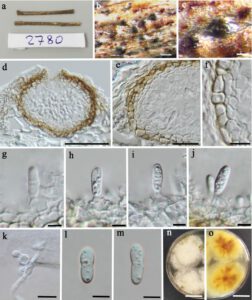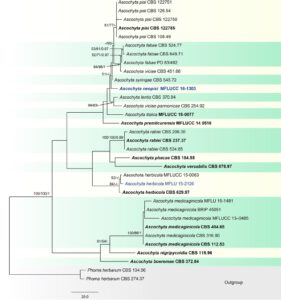Ascochyta neopisi W.J. Li, Camporesi & K.D. Hyde, in Li, McKenzie, Liu, Bhat, Dai, Camporesi, Tian, Maharachchikumbura, Luo, Shang, Zhang, Tangthirasunun, Karunarathna, Xu & Hyde, Fungal Diversity 100: 351 (2020)
Index Fungorum number: IF 557137, Facesoffungi number: FoF 07123, Fig. 1
Etymology: Referring to its morphology similar to A. pisi, but phylogeny is distinct
Saprobic on dead stems of Colutea arborescens (Fabaceae). Sexual morph: undetermined. Asexual morph: Conidiomata 80–120 μm diam., 80–100 μm high, brown to black, pycnidial, solitary to gregarious or confluent, immersed, globose, unilocular, thick-walled, glabrous, with a dark brown papillate ostiole. Ostiole short, single, circular to oval, centrally located. Conidiomatal wall 10–20 μm wide, composed of thick-walled, brown cells, gradually merging with hyaline cells of textura angularis. Conidiophores reduced to conidiogenous cells. Conidiogenous cells 5–13 μm × 5–8.5 μm, hyaline, enteroblastic, phialidic, determinate, doliiform to ampulliform, smooth-walled, arising from the inner cavity of the conidiomata. Conidia 10–15 × 4–6.5 μm ( ̄x = 12 × 5 μm; n = 30), hyaline, ellipsoidal to ovoid, obtuse at both ends, straight or slightly curved, 1-septate, constricted at the septum, smooth, guttulate.
Culture characters – Colonies on PDA, reaching 15–20 mm diam. after 7 days at 25–30 °C, with white, flattened, dense, filamentous, aerial, fluffy hyphae on the surface, margin crenate, circular; reverse brown to yellowish in the middle zone, paler toward margins.
Material examined – Italy, Ravenna, Zattaglia, on dead stem of Colutea arborescens (Fabaceae), 30 January 2016, Erio Camporesi, IT2780 (MFLU 16-0291, holotype), living culture MFLUCC 16-1303, (KUM, HKAS 97465, isotype).
Notes – Ascochyta neopisi is similar to A. pisi in having pycnidial conidiomata and 1-septate conidia, but is distinguished by its conidiogenous cells. Ascochyta neopisi has phialidic conidiogenous cells, while A. pisi has annellidic conidiogenous cells. Phylogenetic analyses based on LSU, ITS, rpb2 and tub2 sequence data showed that A. neopisi formed a separate branch basal to A. fabae, A. pisi, A. syringae and A. viciae (Fig. 2).

Fig. 1. Ascochyta neopisi (MFLU 16-0291, holotype). a Herbarium package and specimen. b–c Appearance of brown conidiomata on the host. d Vertical section of conidiomata. e–f Section of peridium. g–j Conidiogenous cells and developing conidia. k Germinated conidium. l–m Conidia. n, o Culture on PDA. Scale bars b = 100 μm, c = 200 μm, d = 50 μm, e = 20 μm, f = 10 μm, g–j, l–m = 5 μm, k = 20 mm,n–o = 10 mm.

Fig. 1. Phylogenetic tree generated from a maximum parsimony analysis based on a concatenated alignment of ITS, LSU, rpb2 and tub2 sequences data representing Ascochyta. The newly generated nucleotide sequences were compared against the GenBank database by blast search. Related sequences were obtained from Chen et al. (2015), Tibpromma et al. (2017) and GenBank. Thirty-three strains are included in the analyses, which comprise 2273 characters including gaps (ITS: 1–489, LSU: 490–1344, rpb2: 1345–1940, tub2: 1941–2273). Phoma herbarum CBS 134.96 and P. herbarum CBS 274.37 are used as the outgroup taxa. The tree topology of the maximum likelihood analysis is similar to either the maximum parsimony or the Bayesian analysis. The best-scoring RAxML tree with a final optimization likelihood value of − 5657.513625 is presented. The matrix had 270 distinct alignment patterns, with 16.63% of undetermined characters or gaps. Estimated base frequencies were: A = 0.242420, C = 0.238519, G = 0.274514, T = 0.244547; substitution rates AC = 0.891880, AG = 4.215502, AT = 1.884133, CG = 0.651574, CT = 11.712755, GT = 1.000000; gamma distribution shape parameter α = 0.020000. The maximum parsimonious dataset consisted of constant 1979, 216 parsimony-informative and 78 parsimony-uninformative characters. The parsimony analysis of the data matrix resulted in the maximum of two equally most parsimonious trees with a length of 439 steps (CI = 0.749, RI = 0.864, RC = 0.647, HI = 0.251) in the first tree. Maximum parsimony (MPBS) and maximum likelihood (MLBS) bootstrap support values higher than 50%, and Bayesian posterior probabilities ≥ 0.95 (PP) are shown above or below the nodes, respectively. Hyphen (“–”) indicates a value lower than 50% for MPBS and MLBS and a posterior probability lower than 0.95 for BYY. The scale bar indicates 20.0 changes. Ex-type and reference strains are in bold. New isolates are shown in bold and highlighted with colour.
